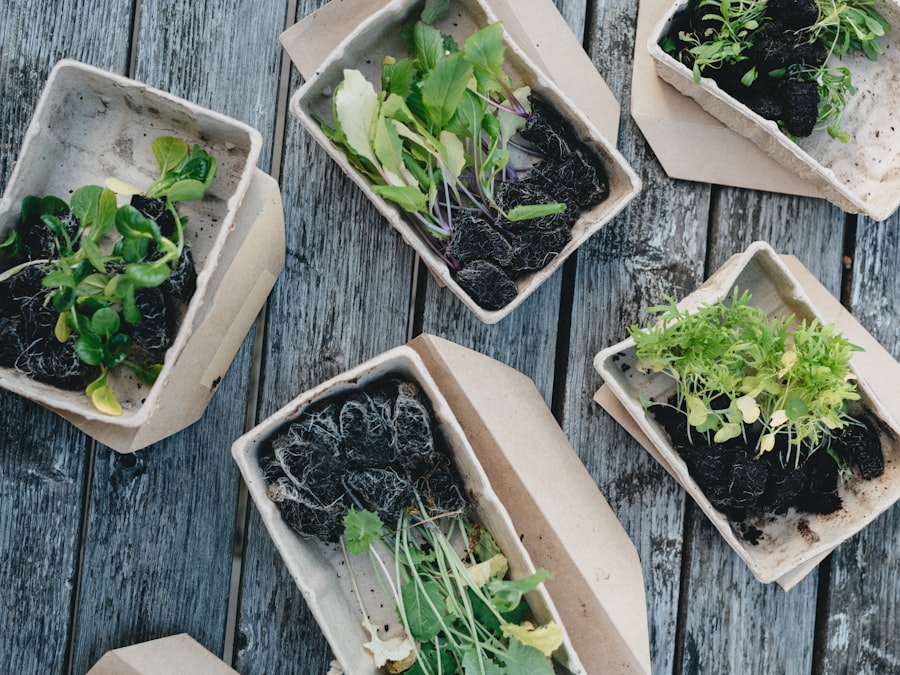In recent years, the packaging industry has witnessed a significant transformation, driven by a growing awareness of environmental issues and the urgent need for sustainable practices. The rise of eco-friendly packaging can be attributed to several factors, including increased consumer consciousness about plastic pollution, climate change, and the overall impact of packaging waste on the planet. As consumers become more informed about the environmental consequences of their purchasing decisions, they are actively seeking alternatives that align with their values.
This shift has prompted companies across various sectors to reevaluate their packaging strategies and adopt more sustainable materials. The transition towards eco-friendly packaging is not merely a trend; it represents a fundamental change in how businesses approach their environmental responsibilities. Traditional packaging materials, particularly single-use plastics, have come under intense scrutiny due to their detrimental effects on ecosystems and human health.
In response, many companies are exploring innovative solutions that minimize their carbon footprint and reduce waste. This movement has led to the emergence of a diverse range of eco-friendly packaging options, including biodegradable materials, recycled content, and plant-based alternatives. As a result, the packaging landscape is evolving rapidly, with businesses recognizing that sustainable practices can enhance brand loyalty and attract environmentally conscious consumers.
Key Takeaways
- Eco-friendly packaging is on the rise as consumers and brands prioritize sustainability.
- Consumer awareness and demand for sustainable options are driving the shift towards plant-based packaging.
- Plant-based packaging offers benefits such as biodegradability, reduced carbon footprint, and renewable resources.
- Innovation and advancements in plant-based materials are leading to more durable and versatile packaging options.
- Many brands are embracing plant-based packaging to meet consumer demand and reduce environmental impact.
Consumer Awareness and Demand for Sustainable Options
The surge in consumer awareness regarding environmental issues has been a driving force behind the demand for sustainable packaging options. With the proliferation of information available through social media and digital platforms, consumers are more informed than ever about the environmental impact of their choices. Reports highlighting the alarming statistics surrounding plastic waste, such as the fact that millions of tons of plastic end up in oceans each year, have galvanized public sentiment.
This heightened awareness has translated into a strong preference for products that utilize sustainable packaging, prompting brands to respond accordingly. Moreover, consumers are increasingly willing to pay a premium for products that demonstrate a commitment to sustainability. Research indicates that a significant percentage of shoppers prioritize eco-friendly packaging when making purchasing decisions.
This trend is particularly pronounced among younger generations, such as Millennials and Gen Z, who are more likely to support brands that align with their values. As a result, companies are not only adopting sustainable packaging as a means of compliance but also as a strategic advantage in a competitive marketplace. The demand for transparency in sourcing and production processes further underscores the importance of sustainable packaging in building trust and loyalty among consumers.
Benefits of Plant-Based Packaging

Plant-based packaging offers numerous advantages over traditional materials, making it an attractive option for businesses seeking to enhance their sustainability efforts. One of the most significant benefits is its biodegradability. Unlike conventional plastics that can take hundreds of years to decompose, plant-based materials can break down naturally within months under the right conditions.
This characteristic significantly reduces the environmental burden associated with waste disposal and contributes to a circular economy where materials are reused rather than discarded. Additionally, plant-based packaging often has a lower carbon footprint compared to petroleum-based alternatives. The production of plant-based materials typically requires less energy and generates fewer greenhouse gas emissions.
For instance, bioplastics derived from renewable resources such as corn or sugarcane can sequester carbon dioxide during their growth cycle, further mitigating their environmental impact. Furthermore, many plant-based packaging solutions are designed to be compostable, allowing consumers to dispose of them in an environmentally friendly manner. This not only encourages responsible waste management but also promotes soil health by returning nutrients to the earth.
Innovation and Advancements in Plant-Based Materials
The field of plant-based packaging is characterized by rapid innovation and advancements in material science. Researchers and companies are continually exploring new ways to enhance the performance and versatility of plant-based materials. For example, advancements in biopolymer technology have led to the development of materials that exhibit properties similar to traditional plastics while being derived from renewable sources.
These innovations enable manufacturers to create packaging solutions that meet the rigorous demands of various industries without compromising on functionality. One notable advancement is the creation of bio-based films that offer excellent barrier properties against moisture, oxygen, and light. These films can be used in food packaging applications to extend shelf life while maintaining product quality.
Additionally, innovations in coating technologies have allowed for the incorporation of plant-based materials into existing packaging systems, providing an eco-friendly alternative without requiring significant changes to production processes. As research continues to progress, the potential for new plant-based materials to replace conventional plastics expands, paving the way for a more sustainable future in packaging.
Brands Embracing Plant-Based Packaging
A growing number of brands across diverse industries are embracing plant-based packaging as part of their commitment to sustainability. Major companies such as Unilever and Coca-Cola have made significant strides in transitioning to eco-friendly packaging solutions. Unilever has set ambitious targets to make all of its plastic packaging recyclable, reusable, or compostable by 2025, with a focus on incorporating more plant-based materials into its product lines.
Similarly, Coca-Cola has introduced bottles made from 100% recycled PET (rPET) and is exploring plant-based alternatives for its beverage containers. In the beauty and personal care sector, brands like Lush and Aveda have taken bold steps towards sustainability by utilizing plant-based packaging materials. Lush has pioneered the use of naked packaging—products sold without any packaging—while also offering items in biodegradable containers made from recycled materials.
Aveda has committed to using 100% recycled or renewable materials for its packaging by 2025, showcasing how brands can lead by example in promoting sustainable practices within their industries.
Overcoming Challenges and Misconceptions

Despite the numerous benefits associated with plant-based packaging, several challenges and misconceptions persist that hinder its widespread adoption. One common misconception is that plant-based materials are inherently less durable or effective than traditional plastics. While it is true that some early iterations of bioplastics faced performance issues, advancements in material science have significantly improved their properties.
Today’s plant-based packaging can rival conventional plastics in terms of strength and barrier performance, making them suitable for a wide range of applications. Another challenge lies in the perception of cost. Many businesses are concerned that transitioning to plant-based packaging will result in higher production costs.
However, as technology advances and economies of scale are achieved through increased demand, the cost differential between traditional and plant-based materials is narrowing. Additionally, companies that invest in sustainable practices often find that they can offset these costs through enhanced brand loyalty and consumer support. Education and awareness campaigns aimed at dispelling myths surrounding plant-based packaging are essential for fostering acceptance among both businesses and consumers.
The Role of Government Regulations and Policies
Government regulations and policies play a crucial role in shaping the landscape of eco-friendly packaging. Many countries have implemented legislation aimed at reducing plastic waste and promoting sustainable alternatives. For instance, several European nations have introduced bans on single-use plastics or imposed taxes on plastic bags to encourage consumers to opt for more sustainable options.
These regulatory measures create a favorable environment for the development and adoption of plant-based packaging solutions. In addition to bans and taxes, governments can incentivize businesses to invest in sustainable practices through grants or tax breaks for companies that adopt eco-friendly packaging solutions. Collaborative initiatives between governments and industry stakeholders can also drive innovation by funding research into new materials and technologies.
By establishing clear guidelines and standards for sustainable packaging, governments can help create a level playing field that encourages companies to prioritize environmental responsibility.
The Future of Plant-Based Packaging in the Market
The future of plant-based packaging appears promising as consumer demand continues to rise and technological advancements pave the way for new innovations. As more brands recognize the importance of sustainability in their operations, the market for plant-based packaging is expected to expand significantly over the coming years. Analysts predict that the global bioplastics market will experience substantial growth as companies increasingly seek alternatives to traditional plastics.
Moreover, as awareness around climate change intensifies, consumers will likely continue prioritizing products with eco-friendly packaging options. This shift will compel more businesses to invest in research and development aimed at creating high-performance plant-based materials that meet consumer expectations while minimizing environmental impact. The convergence of consumer demand, technological innovation, and supportive government policies will undoubtedly shape the trajectory of plant-based packaging in the market, leading to a more sustainable future for both businesses and consumers alike.
In the growing conversation around sustainable practices, the article on why plant-based packaging is winning consumer trust highlights a significant shift in consumer preferences towards eco-friendly products.
You can read more about this in the article on how smartwatches are enhancing connectivity.
FAQs
What is plant-based packaging?
Plant-based packaging refers to packaging materials that are derived from renewable resources such as plants, rather than traditional petroleum-based plastics. These materials can include bioplastics, paper, cardboard, and other natural fibers.
Why is plant-based packaging gaining consumer trust?
Plant-based packaging is gaining consumer trust due to its eco-friendly and sustainable nature. Consumers are becoming more conscious of the environmental impact of traditional plastic packaging, and are therefore more inclined to support products that use plant-based alternatives.
What are the benefits of plant-based packaging?
Plant-based packaging offers several benefits, including reduced reliance on fossil fuels, lower carbon footprint, biodegradability, and compostability. These materials also have the potential to reduce plastic pollution and contribute to a more sustainable future.
Are there any challenges associated with plant-based packaging?
While plant-based packaging offers many benefits, there are also challenges associated with its widespread adoption. These challenges include cost, scalability of production, and potential competition with food resources if not managed sustainably.
How can consumers identify plant-based packaging?
Consumers can identify plant-based packaging by looking for labels or certifications such as “compostable,” “biodegradable,” or specific logos indicating the use of plant-based materials. Additionally, manufacturers often provide information about their packaging materials on product packaging or websites.

